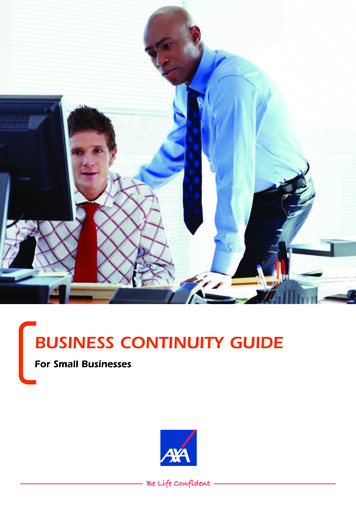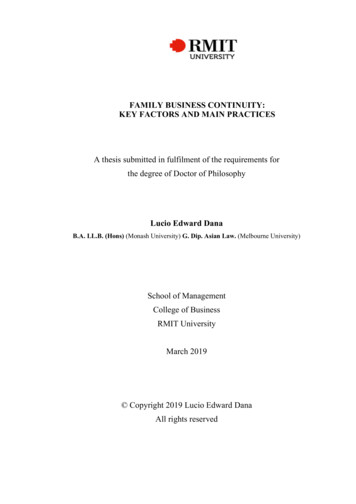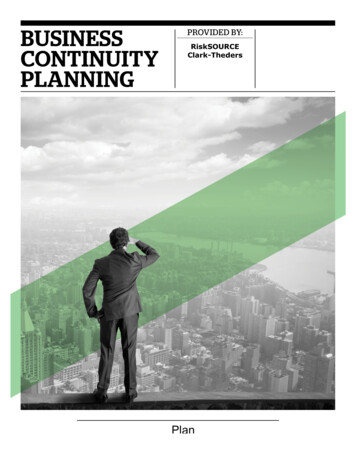
Transcription
Canadian Bar Association, BC BranchWills and Trust Section, VancouverJanuary 29, 2019Continuity Planning for Family-Owned BusinessesThis paper was written by Nicole L. Garton, LL.B., TEP, Principal, Heritage Law andPresident, Heritage Trust for a CBA BC Wills and Trusts Vancouver Section meeting held onJanuary 29, 2019.{00409386}1
SummaryThe overriding objective of any business family when undertaking succession planning is toensure the smooth transition of wealth from one generation to the next, while maintainingfamily harmony and ensuring that the business survives the transition unscathed. Thetraditional approach of business succession and wealth transition planning, which focusseson a one time transactional process of transferring financial assets from one generation tothe next in a tax efficient manner, often gets the timing and order of work wrong.Continuity planning is a long term, multidisciplinary process which starts with the humanelements of the family.Researchers have identified the following four main causes of wealth transfer failures:1.Lack of family mission and vision: 10%;2.Breakdown of trust and communication within the family: 60% ;3.Failure to prepare heirs for roles and responsibilities: 25%; and4.Professional errors in accounting, legal or financial advisory planning: lessthan 5%.1Of note, less than 5% of succession plans that failed, failed due to professional negligence.Commonly implemented succession and wealth transition structures, which are primarilyput in place to minimize or defer taxes and manage risk, result in a failed succession plan,not because of the structures themselves, but in spite of them. The technical skills ofwealth transfer are certainly important and should in no way be diminished. That said,proficient legal and tax planning does not ensure a successful transition of wealth.Traditional succession planning only prepares the assets for the family. Continuityplanning prepares the family for the assets.What follows is an overview of:1. The nature of family business;2. The main theoretical concepts of family business;3. The unique importance of succession for family business;4. The concept of transgenerational wealth; and5. Continuity planning, its process and management.Roy Williams & Vic Preisser, Preparing Heirs: Five Steps to a Successful Transition of Family Wealth and Values, 1edition ed (San Francisco, Calif: Robert Reed Publishers, 2010).1{00409386}2
Table of ContentsSummary .2I.The Nature of Family Business .41.Prevalence of Family Business .42.Definition of Family Business .43.Definition of Family Enterprise.54.Complexity of Family Business .55.Performance of Family Businesses .66.Social Responsibility, Philanthropy and the Family Business .67.Current State of Family Business Research.7II.The Main Theoretical Concepts of Family Business .71.Systems Theory.7(a)2.The Three Circle Model.8Developmental Models.9(a)The Three Dimensional Developmental Model .9(b)The Interfacing Life Cycles Model .10III.The Unique Importance of Succession for the Family Business .11IV.Updated Concepts of Intergenerational Wealth.12V.1.Concept of Transgenerational Wealth .122.Concept of Complete Wealth.13Continuity Planning.141.Definition of Continuity Planning .142.Why Continuity Planning .143.The Continuity Planning Process .154.VI.(a)Governance Planning .15(b)Legal and Tax Planning.20(c)Ongoing Continuity Planning.24Managing the Continuity Planning Process .26(a)Redefining the Client.26(b)Building and Leading a Multi-Disciplinary Team .26Conclusion .28Bibliography .29{00409386}3
I.The Nature of Family Business1. Prevalence of Family BusinessAdvising family businesses is a robust and vibrant practice area – with good reason. Familybusinesses are ubiquitous. About half of the Canadian workforce is employed by a familyenterprise. Canadian family enterprises are estimated to create anywhere from 45 to 60percent of Canadian GDP, and family enterprises create an estimated 70 to 90 percent ofglobal GDP annually.2 Recent research suggests that the actual number of family controlledenterprises in the world may constitute 80 percent of all businesses. That said, there arediscrepancies between sources, largely because there is a lack of consensus on what ismeant by family, let alone what is meant by the term family business.32. Definition of Family BusinessAlthough there is no common definition of what constitutes a family business, familybusinesses generally have the following characteristics:1. Multiple members of the same family are involved as major owners or managers,either contemporaneously or over time;42. The family controls the business through involvement in ownership andmanagement positions;53. The family has intergenerational intent;6 and4. The business contributes significantly to the family’s wealth, income and/oridentity.7Jennifer Halyk, Research Matters in the Family Enterprise Field: Where Theory and Practise Meet (Sauder Schoolof Business Business Families Centre, 2012).3 Joseph H Astrachan, Sabine B Klein & Kosmas X Smyrnios, “The F-PEC Scale of Family Influence: A Proposal forSolving the Family Business Definition Problem1” (2002) 15:1 Family Business Review 45.4 Danny Miller et al, “Are family firms really superior performers?” (2007) 13:5 Journal of Corporate Finance 829 at836.5 Inc The Family Firm Institute, Family Enterprise: Understanding Families in Business and Families of Wealth, Online Assessment Tool, har/psc edition ed (Hoboken, New Jersey: Wiley, 2013) at 2.6 Jon C Carr & Jennifer M Sequeira, “Prior family business exposure as intergenerational influence andentrepreneurial intent: A Theory of Planned Behavior approach” (2007) 60:10 Journal of Business Research 1090.7 Amy M Schuman, Wendy Sage-Hayward & David Ransburg, Human Resources in the Family Business: Maximizingthe Power of Your People, 1st ed. 2016 edition ed (Basingstoke, Hampshire : New York, NY: Palgrave Macmillan,2015).2{00409386}4
3. Definition of Family EnterpriseWhereas the concept of a family business often implies a singular business unit such as astore, office or factory, a family enterprise often refers to a portfolio of businesses orinitiatives that a family may be involved in. These initiatives include not only one or moreoperating business units, but also can include portfolios of other assets to be managed andshared, including financial, real estate, philanthropic, heirloom and deferred assets:89In fact, family enterprises are the norm as 89.4% of families control more than a singlefirm, with the mean number of firms controlled by a family at 3.4.104. Complexity of Family BusinessThe complexity of family enterprises arises from trying to balance family demands and theneeds of the business, while at the same time addressing the complex interaction betweenthe two. As well as dealing with commonplace business issues, such as changes in businessand technological markets and challenges from competitors, family businesses must dealwith the unique psychological dimensions of having family members work together.Each of the family members in the business will have their own objectives, perspectivesand goals. Working together intensifies family interactions and can exacerbate familyproblems such as sibling rivalry or competition between the generations. Unresolvedconflicts and diminishing communication and trust can undermine the operation of thebusiness and ultimately result in a detrimental effect on the business.Key issues to be tackled include effective decision-making across the family, managementand ownership arenas, conflict resolution, facilitating effective ownership of the business,balancing the involvement and performance management of family members with theirskill set and those required by the business, while above all operating in the best interestsof the business and family as a whole.Deferred assets are assets that do not come into play until after death, like insurance and annuities.Family Enterprise Model (Family Enterprise Xchange, 2018).10 Mattias Nordqvist & Thomas Zellweger, “Transgenerational Entrepreneurship: Exploring Growth andPerformance in Family Firms Across Generations” (2010) .89{00409386}5
5. Performance of Family BusinessesResearch has demonstrated that family firms are top performers. While family businessescertainly confront many challenges, they also possess advantages born out of a unique anddynamic owner-manager-family interaction. Whether measured by the bottom line, valuecreation for shareholders or their capacity to create jobs, family companies oftenoutperform their non-family counterparts.11 A Thomson Financial study for Newsweekcompared family firms to rivals on the six major indexes in Europe and showed that familycompanies outperformed their rivals on all of these indexes, from London’s FTSE toMadrid’s IBEX.12 Authors have argued that family businesses often outperform non-familyfirms due to their long term outlook and lack of pressure from shareholders driven byshort term financial goals.13The term “familiness” has been developed and widely accepted to describe the uniquebundle of resources, available for establishing a strategic advantage, held by and particularto family firms as a result of their unique systems, interaction among the family, individualmembers and the business itself. It may be that these “familiness qualities,” including, butnot limited to, strategic focus, customer orientation, family relationships, and operationalefficiency, contribute to the superior performance of family versus non-family firms.146. Social Responsibility, Philanthropy and the Family BusinessResearch has shown that family firms are often more socially responsible than non-familyfirms along several dimensions. In fact, the majority of research on this subject suggeststhat family enterprises tend to exhibit higher levels of corporate social responsibility andgreater citizenship in the community than non-family firms.15 Researchers theorize thatthis is likely due to family concern about image and reputation and a desire to protectfamily assets.16Ernesto J Poza, Family Business, 3 edition ed (Mason, Ohio: South-Western College Pub, 2009) at vii.IFC International Finance Corporation, IFC Family Business Governance Handbook (World Bank Group) at 12.13 Doug Baumoel & Blair Trippe, Deconstructing Conflict: Understanding Family Business, Shared Wealth andPower, first edition ed (Continuity Media, 2016) at 6.14 John Tokarczyk et al, “A Resource-Based View and Market Orientation Theory Examination of the Role of‘Familiness’ in Family Business Success” (2007) 20:1 Family Business Review 17.15 Pascual Berrone et al, “Socioemotional Wealth and Corporate Responses to Institutional Pressures: Do FamilyControlled Firms Pollute Less?” 32.16 W Gibb Dyer & David A Whetten, “Family Firms and Social Responsibility: Preliminary Evidence from the S&P500” (2006) 30:6 Entrepreneurship Theory and Practice 785.1112{00409386}6
7. Current State of Family Business ResearchFamily business research is the study of family-owned and managed businesses, and theirsubsystems that affect the way they operate. The interest in family firm research hasgrown significantly in recent years, leading to an emerging field of study within businessresearch. The underlying assumption of this research field is that family firms haveparticular characteristics that distinguish them from non-family firms. Despite the progressmade in the identification of these differences, especially in the last decade, research onfamily firms remains a new field which is still building legitimacy within managementstudies.17II.The Main Theoretical Concepts of Family Business1. Systems TheorySystems theory is the theoretical approach most often used in the scholarly study of familybusiness. A system is a network of interdependent components that work together to tryto accomplish the aim of the system.18 Five principles of systems thinking that impact onfamily businesses are as follows:1. The whole is greater than the sum of its parts;2. Organizations seek homeostasis: trying to keep things stable or the same;3. Patterns of behaviour are predictable over generations;4. Every action creates a non-linear reaction, like a ripple in a pond; and5. Interfacing life cycles imply constant changes.19(a) The Three Circle ModelIn the systems theory approach, the family firm is modeled as comprising threeoverlapping, interacting and interdependent subsystems of family, ownership andmanagement.20Sascha Kraus, Rainer Harms & Matthias Fink, “Family Firm Research: Sketching a Research Field” (2011) 13 Int Jof Entrepreneurship and Innovation Management 32.18 William Edwards Deming, The New Economics: For Industry, Government, Education (MIT Press, 2000) at 50.19 Family Enterprise Exchange, Business Family Dynamics (2018) at 14.20 Renato Tagiuri & John Davis, “Bivalent Attributes of the Family Firm” (1996) 9:2 Family Business Review 199.17{00409386}7
Each subsystem maintains boundaries that separate it from the other subsystems and thegeneral external environment within which the family business operates. This modelsuggests that a family firm is best understood and studied as a complex and dynamicsystem in which each of the subsystems has a strong impact on the other subsystems andaccordingly the larger system as a whole.If a person has one role, they will be in just one subsystem or circle. However, if they havemore roles, they will be in an overlapping sector, sitting within two or three circles at onetime. Within the three circle model, there are seven distinct groups with a connection to thefamily business:1. Family members not involved in the business, but who are descendants orspouses/partners of owners;2. Family owners not employed in the business;3. Non-family owners who do not work in the business;{00409386}8
4. Non-family owners who work in the business;5. Non-family employees;6. Family members who work in the business but are not owners; and7. Family owners who work in the business.Each of the seven interest groups identified by the model has its own viewpoints, goals,concerns and dynamics. The long-term success of family business system depends on thefunctioning and mutual support of each of these groups.2. Developmental ModelsWhereas the three circle model (business, ownership, and family) helps to assess a familybusiness at a certain point of time, a developmental approach helps to identify dilemmasand problems that arise due to changes within the business, the family and the distributionof ownership over time.21(a) The Three Dimensional Developmental ModelIn each of the three subsystems – ownership, family and business – there is a separatedevelopmental dimension. The ownership subsystem goes through its sequence of stages,the family subsystem has its own sequence and the business also progresses through asequence of stages. These developmental progressions influence each other, but they arealso independent. Each part changes at its own pace and according to its own sequence. Asthe family business moves to a new stage in any of the dimensions, it takes on a new shape,with new characteristics.22John A Davis et al, Generation to Generation: Life Cycles of the Family Business, Kelin E. Gersick, ed. (HarvardBusiness Review Press, 1997) at 15.22 Ibid at 18.21{00409386}9
23The family axis of the developmental model was influenced by the psychologists ErikErikson and Daniel Levinson and their stages of life theories.24 The ownership axis isderived from the work John Ward on how successive stages of family ownership result infundamental differences in every aspect of the family business.25 The business axis is amerger of numerous business life-cycle models. The overall model provides a frameworkfor understanding family businesses over time in each dimension, and suggests how arecognition of the current stage, and the interaction of the various stages across theownership, family and business subsystems, could help with the analysis of the dynamics ofthe family business.(b)The Interfacing Life Cycles ModelThe interfacing life cycles model builds on the developmental model by adding two moreaxes: industry and individual.26Ibid at 17.Martin Gerstein & Michele Papen-Daniel, Understanding Adulthood. A Review and Analysis of the Works of ThreeLeading Authorities on the Stages and Crises in Adult Development. California Personnel and Guidance AssociationMonograph Number 15 (California Personnel and Guidance Association, 654 East Commonwealth Ave, 1981).25 Keeping the Family Business Healthy - How to Plan for Continuing Growth, Profitability, and Family Leadership J. Ward Palgrave Macmillan.26 Kets de Vries et al, Family business on the couch. A psychological perspective. (Chichester: John Wiley & Sons,2007).2324{00409386}10
The model is based on the assumption that the most intractable family business issues arenot the business problems the organisation faces, but the psychological and emotionalissues that compound them. Applying the model is intended to help to explain behaviourand enable the family to prepare for life cycle transitions and other issues that may arise inthe family business.III.The Unique Importance of Succession for the Family BusinessFamily businesses are unique in the extent to which succession planning assumes a keyrole in the firm’s life. Because business competitive success, family harmony andownership returns are all at stake at the same time in the firm, carefully orchestrating themulti-year succession process across generations of owner-managers is a priority. Infamily owned companies, the most common reason they fail is related a failure insuccession planning.Regularly quoted succession statistics of family businesses are grim. John Ward’s seminalstudy in 1987 found that only 30 percent of family businesses are successfully transferredto the next generation from the founding family owners. And the odds get worse in the{00409386}11
transitions between the second and third generations and the third and fourth generations,when only 13 percent and 3 percent of such businesses remain in the founding family.27These often repeated succession statistics seem to prove true the old adage “fromshirtsleeves to shirtsleeves in three generations.” The phrase encapsulates the theory thatthe first generation of an enterprising family spends its lifetime working hard and livingfrugally, the second generation enjoys a comfortable lifestyle, eventually entering elitesociety, and the third generation grows up in luxury, doing little or no work whilesquandering the family fortune.IV.Updated Concepts of Intergenerational WealthJohn Ward’s 30/13/3 statistic has been largely unchallenged in mainstream literature andmedia coverage of family-owned businesses. It seems to suggest that there is somethingfundamentally “wrong” with family firms, and that they inevitably fall into the threegeneration survival trap. Even though the survival rates of non-family firms are by nomeans larger, family business research has contributed to a rather negative outlook offamily business succession in particular. Existing family firm survival studies often neglectthe portfolio of entrepreneurial activities of business families beyond a core company.Further, most traditional longevity studies fail to acknowledge other forms of successionbeyond passing on the business within the family, such as the sale of the firm as way toharvest value and create new opportunities for the family.281. Concept of Transgenerational WealthThe concept of family-influenced, transgenerational wealth creation re-frames successionby focussing on developing a family’s entrepreneurial tendencies. With transgenerationalwealth creation as a goal, the survival of one family firm - a single operating business - isnot the only way to pursue and achieve long-term success, and low succession rates do notmean that a family enterprise is inept or incapable.29Transgenerational wealth creation allows the next generation to use the family resourcesto take risks and build an entrepreneurial orientation. Proactive, entrepreneurialstrategies such as diversifying assets through a sale or strategic alliances should not meanthat family businesses are considered failures. To grow a family’s wealth and pass it on tosubsequent generations for their stewardship, the next generation should be given theJohn L Ward, “The Special Role of Strategic Planning for Family Businesses”: (2016) Family Business Review,online: 1-6248.1988.00105.x .28 Thomas Markus Zellweger, Robert S Nason & Mattias Nordqvist, “From Longevity of Firms to TransgenerationalEntrepreneurship of Families: Introducing Family Entrepreneurial Orientation” (2012) 25:2 Family Business Review136 at 2.29 Zellweger, Nason & Nordqvist, supra note 29.27{00409386}12
opportunity to take risks and pursue new directions that are essential for multigenerational growth.Succession should only be considered to have failed if the next generation involuntarilyloses control of the transitioned assets. Specifically, if a family business is sold and thefinancial assets are voluntarily redeployed into the financial markets, this is considered arestructuring of those assets, not a failed succession plan. Similarly, if the transitionedfinancial assets are used for philanthropic purposes, that is considered a voluntaryredistribution of those assets. Involuntary losses or succession failure occurs only whenbeneficiaries lose control of their wealth through factors such as "foolish expenditures, badinvestments, mismanagement, inattention, incompetence, family feuding, or other causeswithin their control."302. Concept of Complete WealthAdding to the understanding that successful intergenerational wealth transfer may or maynot involve the transfer of an operating business to the next generation, wealth itself can beunderstood as more than pure financial assets. A conception of a family’s “completewealth” is that, in addition to quantitative, financial capital, it also includes qualitativecomponents, including human, intellectual, social and spiritual capital.31 The family’sfinancial capital is a tool to support the growth of its human, intellectual, social andspiritual capitals. The key concept of complete wealth is that the most important assets ofa family are in fact its individual members.32(a) Human CapitalThe human capital of a family consists of the individuals who make up the family. Theirhuman capital includes their physical and emotional well-being as well as each member’sability to find meaningful work and establish a positive sense of identity.33 When speakingabout human capital, it includes effective parenting and grand-parenting, communication,consensus building, team building, conflict resolution, leadership training, values, moralsand ethics and goal setting.34(b)Intellectual CapitalThe intellectual capital of a family is composed of the knowledge gained through the lifeexperiences of each family member and what each family member knows. IntellectualWilliams & Preisser, supra note 1 at 16.James E Hughes Jr, Susan E Massenzio & Keith Whitaker, Complete Family Wealth, 1 edition ed (Hoboken, NewJersey: Bloomberg Press, 2017) at 9.32 Ibid at 36.33 Ibid at 11.34 Lee Hausner & Douglas K K Freeman, The Legacy Family: The Definitive Guide to Creating a SuccessfulMultigenerational Family, 2010 edition ed (New York: Palgrave Macmillan, 2009) at 7.3031{00409386}13
capital includes family members’ academic successes, career growth, artistic achievements,financial literacy and the ability to learn and teach what they know.35(c) Social CapitalSocial capital refers to family members’ relationships with each other and the largercommunity. It also refers to the family’s ability to share and sustain an intention thattranscends each member’s individual interests, often in the form of volunteer andphilanthropic activities.36(d)Financial CapitalFinancial capital of a family is the property it owns. It comprises all branches of the familyenterprise, including operating business assets, financial assets (cash, public securities,privately held company stock, interests in private partnerships), real estate assets,philanthropic assets, heirloom assets and deferred assets. Financial capital is the tool thatthat facilitates the cultivation of the other forms of capital.37V.Continuity Planning1. Definition of Continuity PlanningThe traditional approach of succession and wealth transition planning, which focusses on aone time transactional process of transferring financial assets from one generation to thenext in a tax efficient manner, often gets the timing and order of work wrong. Successfulcontinuity planning is a long term, multidisciplinary process which starts with the humanelements of the family.2. Why Continuity PlanningA study of 3,250 families over twenty years found the following four main causes of wealthtransfer failures:1.Lack of family mission and vision: 10%;2.Breakdown of trust and communication within the family: 60% ;3.Failure to prepare heirs for roles and responsibilities: 25%; andJr, Massenzio & Whitaker, supra note 33 at 11.Hausner & Freeman, supra note 36 at 7.37 Jr, Massenzio & Whitaker, supra note 33 at 12.3536{00409386}14
4.Professional errors in accounting, legal or financial advisory planning: lessthan 5%.38Of note, less than 5% of succession plans failed due to professional negligence. Thecommonly implemented succession and wealth transition structures, which are mostlyestablished to minimize or defer taxes and manage risk, result in a failed succession plan,not because of the structures themselves, but in spite of them.39 The backbone of continuityplanning is for advisors to work together over time in multi-disciplinary teams in order toaddress both “soft” and “hard” issues to truly help business family clients. The technicalskills of wealth transfer are certainly important and should in no way be diminished. Thatsaid, proficient legal and tax planning does not ensure a successful transition of wealth.Rather, it is how well the family is prepared to deal with the transition of wealth that ismuch more important.3. The Continuity Planning ProcessThe overriding objective of any family when undertaking continuity planning is to ensurethe smooth transition of wealth from one generation to the next while maintaining familyharmony and ensuring that the business survives the transition unscathed. A continuityplan is far more likely to be successful if it is borne out of early preparation and thecoordination of the three circles: family, ownership and business. Continuity planningrequires the setting of
Continuity planning prepares the family for the assets. What follows is an overview of: 1. The nature of family business; 2. The main theoretical concepts of family business; 3. The unique importance of succession for family business; 4. The concept of transgenerational wealth; and 5. Continuity planning, its process and management.










